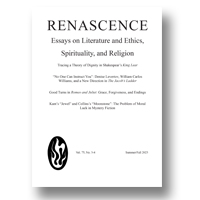|
|
|
1.
|
Renascence:
Volume >
65 >
Issue: 2
Joshua Avery
Falstaff’s Conscience and Protestant Thought in Shakespeare’s Second Henriad
abstract |
view |
rights & permissions
| cited by
Building on previous speculations on the theological meaning Shakespeare intends with Falstaff, this essay argues that the character dramatizes the apprehension that tends to accompany a Protestant soteriology. Falstaff’s teasing Bardolph about his spiritual destiny bespeaks fright about himself, with the invoked memento mori calling attention to the unavailability of comforting ideas such as purgatory and self-determined repentance. Similarly, Falstaff’s forays into military impressment figure the incomprehensible nature of divine election, from a Protestant view. Through Falstaff, Shakespeare is not offering a theological argument, so much as expressing sympathy for those afflicted with the anxieties to which Protestantism might leave them vulnerable.
|
|
|
|
|
|
|
2.
|
Renascence:
Volume >
65 >
Issue: 2
Ethan Smilie
Satan’s Unconquerable Will and Milton’s Use of Dantean Contrapasso in Paradise Lost
abstract |
view |
rights & permissions
| cited by
Citing the poem’s most obvious example, the devils’ forced transformation into snakes, this essay argues that the Dantean contrapasso at work in this Book Ten episode factors more generally into Paradise Lost. In Dante’s Inferno, often the damned suffer punishments in which they reenact for eternity the sins they committed in life. The same principle applies to Milton’s Satan, and all the devils. Book Five’s account of their initial rebellion, wherein Satan misleads them and they prove willfully misled, sets the pattern by which he and his followers are debased. Such debasement, culminating in the death of the sinner’s will, also pertains to Milton’s idea of the spiritual condition of any human sinner.
|
|
|
|
|
|
|
3.
|
Renascence:
Volume >
65 >
Issue: 2
Jack Dudley
Transcendence and the End of Modernist Aesthetics:
David Jones’s In Parenthesis
abstract |
view |
rights & permissions
| cited by
Taking into account Jones’s adoption of principles of modernist poetics—juxtaposition, allusion, and parataxis, all geared “to create newness”—this essay examines the theological ramifications for the poet’s breaking down, in his semi-autobiographical World War I poem, of modernist order and control. Jones unravels modernist aesthetics, conveying their inadequacy to the brutal realities of war. A space for religious belief appears through this process, but one not of heightened understanding; instead it is a via negativa, an unknowing, consonant with ideas from medieval mysticism but applied to the modern Waste Land. This pattern is borne out in Jones’s handling of the medieval trope of “misadventure,” his references to Eliot, his play on the word “line,” and his development of the concept of “parenthesis.”
|
|
|
|
|
|
|
4.
|
Renascence:
Volume >
65 >
Issue: 2
Robert Lance Snyder
“What or Who is King Kong?”:
Graham Greene’s The Captain and the Enemy
abstract |
view |
rights & permissions
| cited by
Positing that the significance of The Captain and the Enemy, Greene’s last fictional narrative, has been under-appreciated, this essay treats the novel as “a metafictional parable in which he adumbrates the fate of writing in an age no longer attuned to the nuances of ‘mystery.’” The narrator Baxter struggles to position the Captain as a romanticized father-figure and demystify the Captain’s lifelong commitment to his lover, Eliza. The mystery of love sustains itself in the “quotidian manifestations of unselfish constancy” Baxter discovers and cannot explain. Greene hereby explores the enigma of human love and reflects on his career-long preoccupations as a writer and a Catholic.
|
|
|
|
|
|
|
5.
|
Renascence:
Volume >
65 >
Issue: 2
Notes on Contributors
view |
rights & permissions
| cited by
|
|
|
|





